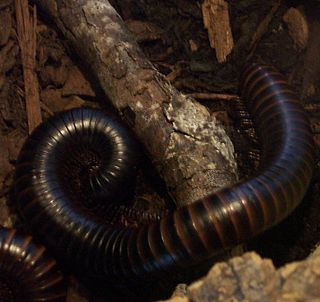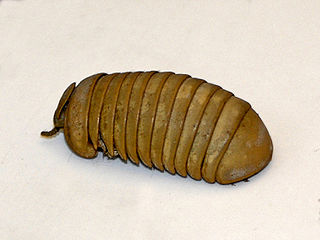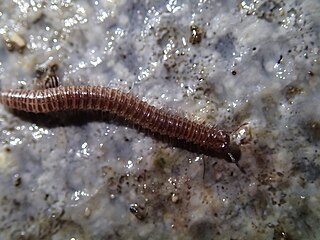
Spirostreptus is a genus of giant millipedes of the family Spirostreptidae. It contains the following species:

Orthoporus is a genus of spirostreptid millipedes, containing around 80 species, distributed from the southern United States to Brazil and Argentina.

Julidae is a family of millipedes in the order Julida, containing more than 600 species in around 20 genera. Its members are largely confined to the Western Palaearctic, with only a few species extending into the Oriental and Afrotropical realms. They are united by a characteristic form of the mouthparts, and are classified in the superfamily Juloidea of the order Julida, alongside the families Trichoblaniulidae, Rhopaloiulidae and Trichonemasomatidae.

Orthomorpha is a genus of millipedes in the family Paradoxosomatidae containing approximately 50 species distributed in Southeast Asia.

Chordeumatida is a large order of millipedes containing some 1200 species with a nearly worldwide distribution. Also known as sausage millipedes, they grow and develop through a series of moults, adding segments until they reach a fixed number in the adult stage, which is usually the same for a given sex in a given species, at which point the moulting and the addition of segments and legs stop. This mode of development, known as teloanamorphosis, distinguishes this order from most other orders of millipedes, which usually continue to moult as adults, developing through either euanamorphosis or hemianamorphosis.

Andrognathidae is a family of millipede in the order Platydesmida. There are about 17 genera and more than 30 described species in Andrognathidae.

Zephronia is a genus of giant pill millipedes in the family Zephroniidae. This genus includes 47 species distributed throughout N. India, Myanmar, Thailand, Malayan Peninsula, Java, Sumatra and Borneo.

Geophilus is a large, heterogeneous genus of soil centipedes in the family Geophilidae largely considered to be synonymous with Brachygeophilus. The generic name first appeared in Brewster's Edinburgh Encyclopaedia in 1814 as Geophilus electricus. This genus has a Holarctic distribution.

Anoplodesmus is a genus of millipedes. It is one of the most species rich genera in the family Paradoxosomatidae, with over 40 described species distributed from India and Nepal to China and Southeast Asia, as well as the Mascarene Islands and Fiji.

Craspedosomatidae is a family of millipedes in the order Chordeumatida. Most adult millipedes in this family have 30 segments, but some have only 28. There are at least 30 genera and 210 described species in Craspedosomatidae.

Anamastigona is a genus of millipedes in the family Anthroleucosomatidae. There are about 20 described species in Anamastigona, found mainly in Europe and the Middle East.

Ophyiulus is a genus of millipedes in the family Julidae. There are more than 30 described species in Ophyiulus.

Rhinotus is a genus of millipedes in the family Siphonotidae. There are at least 20 described species in Rhinotus.

Trigoniulus is a genus of millipede in the family Trigoniulidae. There are at least 90 described species in Trigoniulus.

Metopidiotrichidae is a family of millipedes in the order Chordeumatida. These millipedes range from 4 mm to 17 mm in length. Adult millipedes in this family have 32 segments, not the 30 segments usually found in this order. Adult males in this family often feature a reduced or vestigial leg pair 10 as part of the gonopod complex, in addition to the two leg pairs typically modified into gonopods in this order. There are about 9 genera and at least 70 described species in Metopidiotrichidae.
Termitodesmidae is a family of millipedes belonging to the order Glomeridesmida. These millipedes are found in India, Sri Lanka, and Vietnam. The five known species in this family are notable in that they are found only in termite mounds. Termitodesmidae is the only myriapod family known to depend on insects in such a commensal relationship.
Siphonophora is a genus of millipedes belonging to the family Siphonophoridae.

Cryptops sometimes known as cave centipedes, is a centipede genus in the family Cryptopidae; species records have a world-wide distribution.
Monographis is a terrestrial genus of millipede in the family Polyxenidae comprising 10 species.
Schendylops is the largest genus of centipedes in the family Schendylidae, containing more than 60 species. This genus was first proposed by the American biologist Orator F. Cook in 1899 for the type species originally named Schendyla grandidieri in 1897. Most species in this genus are found in the Neotropical region, but a dozen species are found in Africa and Madagascar. These species live in diverse habitats, ranging from sea level to high altitudes.















